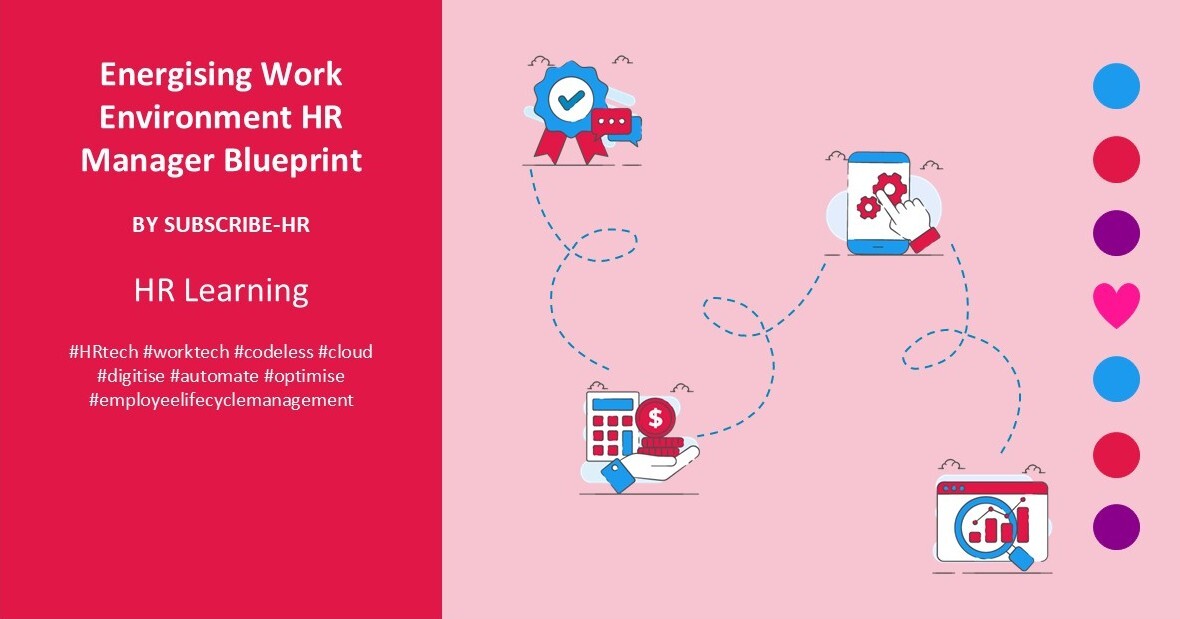Every Monday morning, you can feel it. That collective sigh rippling through your office as people settle into their desks with all the enthusiasm of someone facing a root canal.
Your employee engagement scores are flatlining. Good people keep leaving for "better opportunities." Team meetings feel like hostage negotiations. You've tried everything: flexible working, wellness programs, team-building events, even that expensive coffee machine. Nothing sticks.
Meanwhile, your competitors seem to have cracked some mysterious code – their people are genuinely excited about their work, their retention rates make yours look embarrassing, and their productivity numbers are climbing whilst yours plateau.

What do the world's most energising workplaces have that yours probably doesn't?
It's not unlimited holiday policies (though that's nice). It's not free lunches or standing desks or meditation apps. It's not even psychological safety, though that matters too.
The secret isn't what you think. It's not about more benefits or bigger budgets. It's about understanding the four scientifically-proven energy drivers that turn ordinary workplaces into environments where people thrive. And once you know them, everything changes.
Let’s dive right in ⬇️
The Science Behind Energising Work Environments
Before diving into practical strategies, we need to understand exactly what we're building.
An energising work environment isn't just about making people happy, though happiness certainly plays a part. It's about creating conditions where employees experience what researchers call "vitality at work": that state where people feel physically energised, mentally sharp, and emotionally connected to their roles.
Recent research from primary healthcare settings identified four critical predictors for energy-building experiences at work, ranked by their statistical impact:
- Recovery opportunities → 2.78x more likely to create energy
- Autonomy in decision-making → 2.26x more likely
- Positive workplace characteristics → 2.09x more likely
- Meaningful internal work experiences → 1.88x more likely
Here's what makes this research revolutionary: these factors work synergistically. Employees who experience all four elements don't just add the benefits — they multiply them. This explains why some workplaces seem to have an almost magical quality where everything clicks, whilst others struggle despite investing heavily in employee perks.
The correlation between health and energy at work is remarkably strong (r = 0.54), meaning when we create energising environments, we're not just boosting performance, we're contributing to overall wellbeing.
That's a powerful proposition for any HR leader looking to make a business case for workplace transformation.
Now, you might be thinking: "This sounds great in theory, but what's the reality in most workplaces today?" Unfortunately, the current state of workplace energy tells a troubling story. ⬇️

The Energy Crisis at Work in 2025
The data paints a sobering picture of workplace energy levels across industries:
There’s an engagement emergency…
- 62% of the global workforce is "not engaged" (do the bare minimum) and 15% are "actively disengaged"
- Only 60% of employees feel they can take time off without falling behind
- 68% struggle to disconnect during non-work hours
- 69% feel pressure to check messages outside of work hours
A manager overload…
76% of HR leaders report their managers are overwhelmed by growing responsibilities
- 73% say leaders aren't equipped to lead change effectively
- Managers now juggle 51% more responsibilities than they can handle
- 25% of Australian people managers believe engagement decreased over past 12 months
And a trust deficit.
- 60% of employees report financial stress – higher than during the pandemic
- 41% of HR leaders say hybrid work compromises employees' connection to culture
- Only 37% of employees believe they have the materials and equipment to do their work properly
⛳ These statistics represent millions of people dragging themselves to work each day, depleted rather than energised.
But here's where it gets interesting: the organisations bucking these trends share remarkably similar characteristics in how they approach workplace energy.
So what exactly are these high-energy organisations doing differently? The answer lies in mastering four fundamental pillars that most workplaces completely overlook.
The Four Pillars of an Energising Work Environment
Pillar 1: Strategic recovery architecture
The highest predictor of workplace energy isn't what you might expect.
It's not motivation, recognition, or even meaningful work – it's recovery.
But we're not talking about mandatory yoga sessions or meditation apps (though those can help). We're talking about systematic integration of recovery into the fabric of work itself.
Micro-recovery implementation
Create structured opportunities for cognitive rest throughout the workday.
Research shows that employees who have access to brief recovery periods, even as short as 2-3 minutes between intensive tasks, maintain higher energy levels throughout the day.
Here's a practical framework you can implement immediately:
The energy rhythm audit
- Track energy levels hourly for one week
- Identify peak performance windows
- Map recovery needs against workload demands
- Design personalised rhythm patterns
- Build team schedules around collective energy flows
Recovery-focused policies:
Once you understand your team's natural energy rhythms, you can start implementing policies that work with these patterns rather than against them:
- Breathing room: Minimum 10-minute gaps between back-to-back meetings
- Quiet zones: Dedicated spaces for cognitive recovery
- Permission culture: Explicit approval for restorative breaks without justification
- Protected time: Meeting-free blocks for deep work and recovery
But recovery alone isn't enough. The second pillar addresses a fundamental human need that most managers accidentally undermine every single day.

Pillar 2: Autonomy-supportive leadership
Autonomy isn't about letting people do whatever they want, it means creating frameworks where employees have genuine choice and control over their work experience whilst maintaining accountability for outcomes.
The research is compelling: autonomy-supportive managers foster 2.26 times higher likelihood of energy-building experiences. But what does autonomy support actually look like in practice?
How to support autonomy
🎯 Choice architecture
Provide meaningful options in how work gets done whilst maintaining clear expectations for what needs to be achieved.
🔍 Rationale transparency
When constraints exist, explain the reasoning behind them rather than simply imposing rules.
🚀 Initiative encouragement
Actively encourage employees to propose improvements and take ownership of solutions.
Not sure where your management style currently stands? Use this quick assessment to find out:
Template: Manager autonomy assessment
Rate your management approach (1-5 scale):
□ I regularly ask for input before making decisions affecting my team
□ I explain the reasoning behind policies and procedures
□ I encourage team members to solve problems their way
□ I provide choice in how goals are achieved
□ I acknowledge feelings and perspectives, even when I disagree
□ I avoid controlling language ("should," "must," "have to")
Based on your assessment results, here are specific ways to build more autonomy into your team's daily experience:
Practical autonomy builders:
- Flexible arrangements that go beyond location (timing, methods, tools)
- Decision-making authority at appropriate levels
- Budget autonomy for role-specific needs
- Project ownership with outcome accountability
- Learning pathways aligned with career goals
While autonomy addresses the psychological need for control, the third pillar focuses on something equally important but often overlooked: the spaces where your people spend their days.
Pillar 3: Environmental psychology optimisation
Your physical and digital environments are constantly communicating messages about energy, possibility, and belonging. Most workplaces accidentally create environments that drain rather than energise.
The key is conducting a systematic audit of both your physical and digital environments:
The environmental energy audit:
🏢 Physical space factors:
- Natural light exposure and quality
- Air quality and temperature control
- Noise levels and acoustic design
- Colour psychology and visual stimulus
- Space for both collaboration and solitude
💻 Digital environment factors:
- Tool efficiency and user experience
- Information accessibility
- Communication channel clarity
- Technology reliability and speed
- Digital wellness boundaries
To make this assessment actionable, try this week-long evaluation process:
Template: Workplace energy mapping
Day-by-day assessment:
- Morning energy test: Rate workspace energy on arrival (1-10)
- Midday check: Note energy drains encountered by lunch
- Afternoon analysis: Identify environmental factors affecting focus
- End-of-day reflection: Which elements supported/hindered energy?
- Weekly patterns: Track correlations between environment and performance
Armed with this data, you can implement targeted interventions that transform your workplace from energy-draining to energy-giving:
Environmental interventions:
- Biophilic design: Plants, natural materials, nature views
- Dynamic lighting: Systems that adapt to circadian rhythms
- Acoustic zoning: Different areas for different work types
- Frictionless technology: Tools that enhance rather than frustrate
- Flexible spaces: Areas designed for both solitude and collaboration
Now we come to the fourth and final pillar – one that connects all the others and gives them deeper significance.
Pillar 4: Meaningful work connection
The fourth pillar, meaningful internal work experiences, is about helping employees see and feel the impact of their contributions.
This isn't about grand purpose statements plastered on walls; it's about creating tangible connections between daily tasks and meaningful outcomes.
Here's how to systematically build meaning into everyday work experiences:
The meaning-making framework:
👁️ Impact visibility
Regular, concrete examples of how individual work contributes to team, organisational, or societal outcomes
📈 Skill development connection
Clear links between current tasks and personal growth trajectories
⚖️ Values alignment
Ongoing dialogue about how work activities align with personal and organisational values
🏆 Legacy building
Opportunities to create lasting impact through projects, mentorship, or innovation
These four pillars provide the foundation, but in 2025, there's a fifth element that's becoming increasingly critical: the strategic use of technology to amplify workplace energy.
How to Enhance Energy with Technology
The role of technology in creating energising work environments has evolved dramatically. In 2025, AI and digital tools aren't just productivity enhancers – they're becoming integral to how we design and maintain workplace energy.
AI-powered energy optimisation:
- Predictive analytics for workload distribution
- Personalised learning and development pathways
- Automated administrative task management
- Real-time sentiment and engagement monitoring
- Intelligent meeting scheduling based on energy patterns
Modern HR technology platforms now offer sophisticated tools for monitoring and enhancing workplace energy:
Digital wellness integration: Modern HR technology platforms now offer sophisticated tools for monitoring and enhancing workplace energy:
- Pulse survey automation with energy-specific metrics
- Integration between performance data and wellbeing indicators
- Personalised intervention recommendations based on individual patterns
- Team energy visualisation dashboards for managers
Before implementing new technology solutions, conduct this essential assessment:
Template: Technology energy audit
Before implementing new solutions, assess:
□ Does our technology save or steal employee time?
□ Are our digital tools intuitive or frustrating?
□ Can employees access information quickly when needed?
□ Do our platforms support or hinder collaboration?
□ Are we measuring technology's impact on energy levels?
Technology can amplify your efforts, but the success of any energising workplace ultimately depends on one critical factor: the quality of your managers. And that's where most organisations are facing their biggest challenge.
The Manager Development Imperative
With 75% of HR leaders reporting that managers are overwhelmed and 70% saying current leadership programs aren't preparing managers for the future, manager development isn't just important, it's urgent.
The good news is that energising managers share specific, developable characteristics:
The energising manager profile: Research shows that energising managers share specific characteristics that can be developed through targeted training:
Emotional regulation: Ability to maintain stable, positive emotional states even under pressure.
Cognitive flexibility: Skill in adapting approaches based on individual team member needs and situational demands.
Recovery advocacy: Proactive support for employee rest and renewal, modelling healthy boundaries.
Meaning-making facilitation: Regular conversations about purpose, impact, and growth.
To develop these capabilities systematically, focus your training efforts on these four core areas:
Manager training focus areas:
- Energy-aware coaching: Teaching managers to recognise and respond to energy patterns in their team members.
- Psychological safety creation: Building skills to create environments where people feel safe to be authentic and take risks.
- Autonomy support techniques: Practical tools for providing choice and control whilst maintaining accountability.
- Recovery leadership: Modelling and encouraging sustainable work practices.
But developing great managers is only valuable if you can measure and sustain the energy they help create. This brings us to the critical question of measurement.
Measuring and Sustaining Energy
Creating an energising work environment isn't a one-time project, it's an ongoing process that requires sophisticated measurement and continuous adjustment.
The key is tracking both leading indicators (predictive measures) and outcome measures (results):
Key energy metrics:
Leading indicators:
- Daily energy self-reports
- Recovery opportunity utilisation
- Autonomy satisfaction scores
- Meaning-making conversation frequency
Outcome measures:
- Employee retention rates
- Performance consistency
- Innovation metrics
- Absenteeism patterns
- Internal mobility rates
To make this practical, create a simple monthly tracking system:
Template: Energy dashboard design
Track these seven key areas:
- Individual Energy Levels (1-10 average)
- Team Collaboration Quality Rating
- Recovery Opportunity Usage Rate
- Autonomy Exercise Frequency
- Meaning-Making Conversation Count
- Environmental Satisfaction Score
- Manager Support Effectiveness Rating
Measurement alone isn't enough – you need systems to ensure these energy-building practices become permanent parts of your culture:
Sustainability strategies:
🏗️ Cultural integration
Embed energy awareness into performance reviews, team meetings, and strategic planning
📋 Leadership accountability
Make manager effectiveness in creating energising environments a key performance indicator
📚 Continuous learning
Regular training updates on energy science and implementation techniques
🔄 Feedback loops
Systematic collection and action on employee input regarding energy levels and workplace experience

The bottom line
For the next seven days, pay attention to the energy in your workplace. Really notice it.
Monday morning arrivals: What's the energy as people enter?
Meeting dynamics: Listen to conversation tones
Collaborative sessions: Observe pace and enthusiasm
Break times: Feel the atmosphere during downtime
End-of-day departures: Watch how people leave
Then ask yourself:
Is this the kind of energy that attracts top talent?
Does this energy drive innovation and creativity?
Will this energy create sustainable competitive advantage?
If the answer is no, you know what needs to change. And now you know how to change it. 🙌
Want more actionable HR insights like this? Explore the Subscribe-HR blog for weekly strategies that transform workplace culture, boost engagement, and help you stay ahead of the latest trends shaping the future of work.

